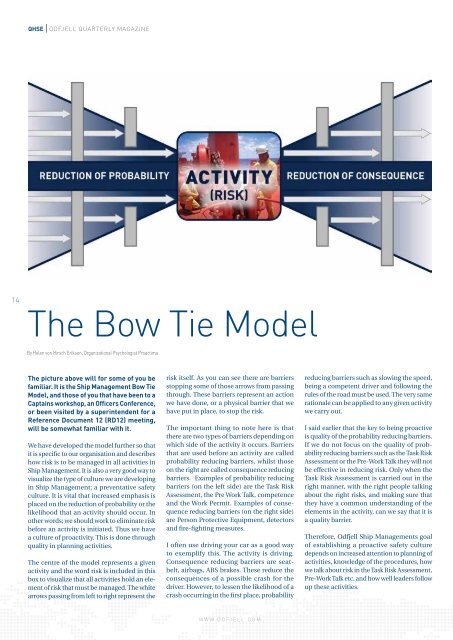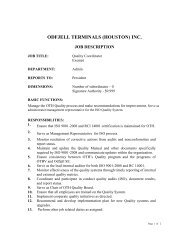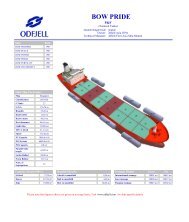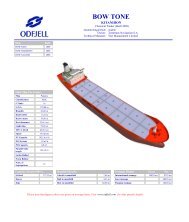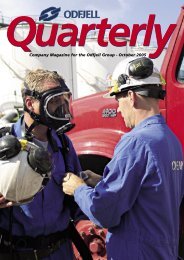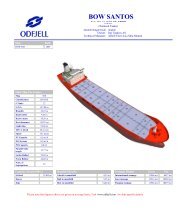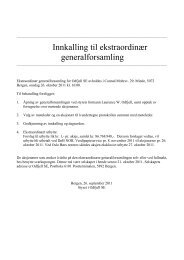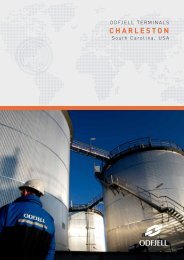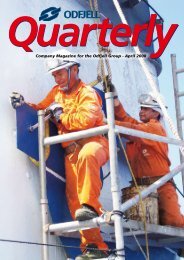Odfjell Quarterly October 2012
Odfjell Quarterly October 2012
Odfjell Quarterly October 2012
- No tags were found...
You also want an ePaper? Increase the reach of your titles
YUMPU automatically turns print PDFs into web optimized ePapers that Google loves.
QHSEODFJELL QUARTERLY magazine14The Bow Tie ModelBy Helen von Hirsch Eriksen, Organizational Psychologist ProactimaThe picture above will for some of you befamiliar. It is the Ship Management Bow TieModel, and those of you that have been to aCaptains workshop, an Officers Conference,or been visited by a superintendent for aReference Document 12 (RD12) meeting,will be somewhat familiar with it.We have developed the model further so thatit is specific to our organisation and describeshow risk is to be managed in all activities inShip Management. It is also a very good way tovisualize the type of culture we are developingin Ship Management; a preventative safetyculture. It is vital that increased emphasis isplaced on the reduction of probability or thelikelihood that an activity should occur. Inother words; we should work to eliminate riskbefore an activity is initiated. Thus we havea culture of proactivity. This is done throughquality in planning activities.The centre of the model represents a givenactivity and the word risk is included in thisbox to visualize that all activities hold an elementof risk that must be managed. The whitearrows passing from left to right represent therisk itself. As you can see there are barriersstopping some of those arrows from passingthrough. These barriers represent an actionwe have done, or a physical barrier that wehave put in place, to stop the risk.The important thing to note here is thatthere are two types of barriers depending onwhich side of the activity it occurs. Barriersthat are used before an activity are calledprobability reducing barriers, whilst thoseon the right are called consequence reducingbarriers. Examples of probability reducingbarriers (on the left side) are the Task RiskAssessment, the Pre Work Talk, competenceand the Work Permit. Examples of consequencereducing barriers (on the right side)are Person Protective Equipment, detectorsand fire-fighting measures.I often use driving your car as a good wayto exemplify this. The activity is driving.Consequence reducing barriers are seatbelt,airbags, ABS brakes. These reduce theconsequences of a possible crash for thedriver. However, to lessen the likelihood of acrash occurring in the first place, probabilityreducing barriers such as slowing the speed,being a competent driver and following therules of the road must be used. The very samerationale can be applied to any given activitywe carry out.I said earlier that the key to being proactiveis quality of the probability reducing barriers.If we do not focus on the quality of probabilityreducing barriers such as the Task RiskAssessment or the Pre-Work Talk they will notbe effective in reducing risk. Only when theTask Risk Assessment is carried out in theright manner, with the right people talkingabout the right risks, and making sure thatthey have a common understanding of theelements in the activity, can we say that it isa quality barrier.Therefore, <strong>Odfjell</strong> Ship Managements goalof establishing a proactive safety culturedepends on increased attention to planning ofactivities, knowledge of the procedures, howwe talk about risk in the Task Risk Assessment,Pre-Work Talk etc, and how well leaders followup these activities.www.odfjell.com


